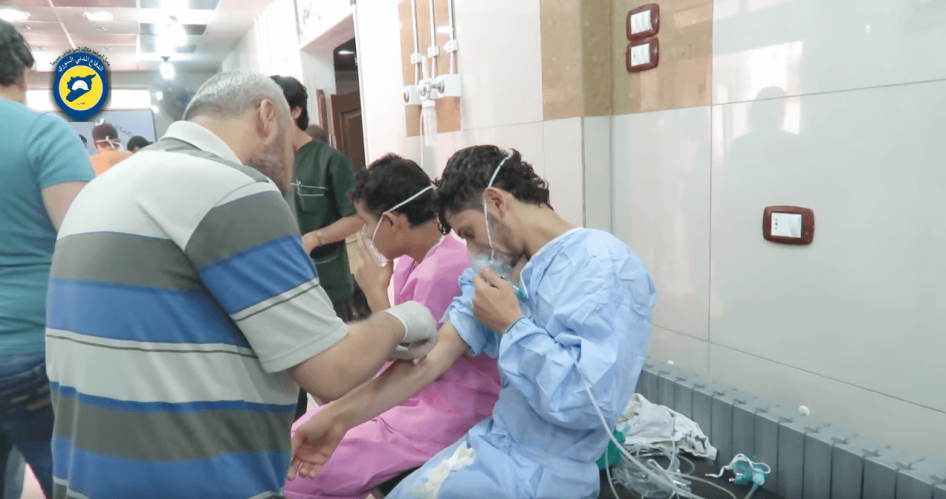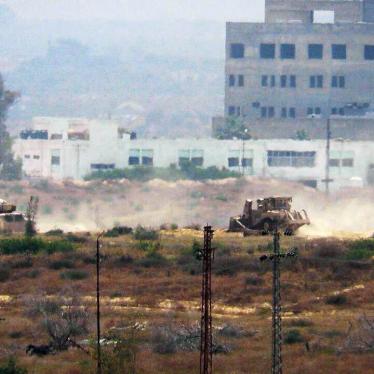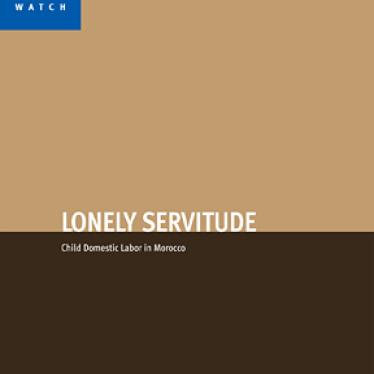(New York) – Syrian government forces apparently used toxic chemicals in two recent attacks in Aleppo, Syria that killed five civilians and injured dozens. New information also indicates that the Islamic State (also known as ISIS) has recently used chemicals as a weapon.
The United Nations Security Council should respond immediately to the credible reports of the attacks, impose individual sanctions, and refer the situation in Syria to the International Criminal Court.
“Even after the UN confirmed the Syrian government’s responsibility for chemical attacks on Syrian civilians, Damascus hasn’t stopped its criminal behavior,” said Ole Solvang, deputy emergencies director at Human Rights Watch. “The Security Council could deter future atrocities by ensuring that the Syrian government faces real consequences for ignoring Security Council resolutions.”
Human Rights Watch phone interviews with local residents, medical personnel, and first responders, as well as reviews of photographs and video footage, indicate that Syrian government helicopters dropped barrel bombs with toxic chemicals on two residential neighborhoods in opposition-controlled parts of Aleppo city, on August 10 and on September 6, 2016.
After each attack, dozens of people suffering from a shortage of breath, coughing, reddened skin and eyes, and excessive tearing sought medical treatment in hospitals. Five people, including three children, died as a result of the attacks, doctors and local activists said.
One doctor described the deaths of two children and their mother from the August 10 attack: “The children were unconscious and unresponsive. Their mother was shivering, coughing, and wheezing. She barely could breathe and was drooling heavily from her mouth.”
A UN-appointed investigation into chemical attacks in Syria will present its fourth and final report on nine attacks in 2014 and 2015 to the Security Council on October 21. The previous report by the Joint Investigative Mechanism (JIM) set up by the UN and the Organisation for the Prohibition of Chemical Weapons (OPCW), attributed two attacks with chlorine, in 2014 and 2015, to the Syrian government and one attack with mustard gas in 2015 to ISIS, which is already under UN sanctions. The Security Council should extend and expand the mandate of the UN-appointed investigation, Human Rights Watch said.
Identifying with certainty the chemical allegedly used in the recent Aleppo attacks without laboratory testing is difficult, but the signs and symptoms reported by victims and medical personnel indicate that government forces probably used chlorine, Human Rights Watch said. Photographs and video footage show remnants of the barrel bombs, including several gas cylinders. Local residents who were close to the impact site and medical personnel said they sensed a strong odor of chlorine, similar to the odor of bleach-based household cleansers, near the impact sites and from the clothes of those affected.
Two doctors said that patients they treated after the September 6, 2016 attack told them that they had seen yellow or green smoke near the impact site. That would be consistent with the use of chlorine, which is a pale yellowish green. Chlorine has many civilian uses but the 1993 Chemical Weapons Convention, which Syria joined in October 2013, bans the use of chemicals as a weapon.
The remnants at the two sites show that the weapons used were barrel bombs, an improvised unguided device usually dropped from a helicopter. Witnesses to the attacks said that they heard the sound of a helicopter above and then of a barrel bomb falling just before they smelled chlorine. There have been no reports of armed opposition groups flying helicopters.
Syrian government helicopters have dropped barrel bombs containing toxic chemicals on opposition-controlled territory at least since April 2014. Human Rights Watch published reports on the use of chemicals as weapons in Syria in May 2014, April 2015, and June 2015.
The Syrian Archive, a platform that collects, curates, and verifies visual evidence of human rights violations, has collected and analyzed 14 videos related to the two attacks.
On August 7, 2015, the Security Council unanimously adopted Resolution 2235, establishing the investigation to “identify to the greatest extent feasible individuals, entities, groups, or governments who were perpetrators, organisers, sponsors or otherwise involved in the use of chemicals as weapons.” At the time, Russia said the investigation would close the gap in identifying those responsible for the use of chlorine as a weapon in Syria. The United States emphasized that “[p]ointing the finger matters.”
The Security Council should renew the joint inquiry’s mandate to allow it to continue its investigation into these and other allegations of chemical weapon attacks in Syria, Human Rights Watch said. Extending the mandate would put all parties on notice that their leaders could be held liable as a matter of command responsibility for chemical attacks by their forces.
The Chemical Weapons Convention prohibits the use of the toxic properties of common chemicals such as chlorine to kill or injure. Among other obligations, each member state agrees never to “assist, encourage or induce, in any way, anyone to engage in any activity prohibited to a State Party under this Convention.” The laws of war applicable in Syria prohibit the use of chemical weapons. The use of prohibited weapons with criminal intent, deliberately or recklessly, is a war crime.
The UN Security Council should impose an arms embargo that would suspend all military sales and assistance, including technical training and services, to all forces credibly implicated in serious violations in Syria, including the Syrian government, Human Rights Watch said. The council should also impose sanctions against officials from all sides who are shown to be implicated in the most serious abuses, and commit to a credible process to ensure criminal accountability for grave abuses by all sides. Human Rights Watch has repeatedly called on the Security Council to refer the situation in Syria to the International Criminal Court.
“It’s appalling that 100 years since the First World War, governments are still using chemical weapons, and even more appalling that Syria has been able to get away with it,” Solvang said. “The Security Council should enforce the chemical weapon treaty ban, which has spared countless civilians from death and excruciating pain.”
September 6 Attack on Aleppo
Shortly after 1 p.m. on September 6, a helicopter dropped a barrel bomb on the Sukkari neighborhood in an opposition-held part of Aleppo, local residents told Human Rights Watch.
Three people who were close to the impact site said that there was no explosion, but that soon afterward, they detected a strong odor of chlorine. Local residents said that there was no opposition military presence in the area at the time of the attack.
One doctor who was at his house near his clinic, coordinating the response to the attack, said:
I could hear the helicopter clearly as it flew in the air above my house. Then I heard the sound of the barrel being dropped. It has a distinct sound. Usually, an explosive barrel makes a very, very loud sound when it lands. But this time there was no such sound. We assumed it didn’t explode. Moments later, one of our personnel arrived. He had chlorine smell on his clothes.
One resident said:
The barrel bomb did not explode, but a few minutes later, I sensed a strong smell of chlorine. People ran in the streets. Their eyes were red and they were coughing heavily. Everyone ran to the water tanks to wash their faces. They were screaming, “Chorine! Chlorine!” It was terrible and scary. I put water on my shirt, covered my face, and ran away.
Bilal Abdul Kareem, an American activist journalist who was only a few blocks from the impact site, gave a similar account:
My cameraman heard the barrel land. When we went closer we saw people sitting in the street with cheap surgical masks, gasping for air. The smell became overwhelming. I became short of breath and my eyes began to sting. There was a strong smell of chlorine – like in a swimming pool.
Abdul Kareem later posted a video report about the attack.
Dozens of people sought medical treatment after the attack, according to medical sources. The al-Quds hospital released a statement in which it said that it had received 71 patients, including 37 children and 10 women. A report from the Omar Abdel Aziz Hospital in Aleppo said that it had treated 36 patients, including 9 women and 8 children. The Syrian-American Medical Society reported that more than 150 people went to three hospitals in Aleppo, including one that it supports.
A local activist said that two people died from the effects of the attack: Abd Al-Kareem Afefeh, 29, died immediately, while Hajar Kiali, 13, died two days later. A doctor confirmed Kiali’s death to Human Rights Watch.
Medical personnel from the three hospitals said that those affected exhibited symptoms including shortness of breath, coughing, and swollen and red eyes. Some fainted and vomited, one doctor said. The report from the Omar Abdel Aziz Hospital listed similar symptoms.
At the hospitals, first responders and medical personnel undressed and washed the patients and administered oxygen and antihistamine. “Even before the attack we had a shortage of oxygen bottles,” one doctor said. “Suddenly, we had to treat 36 patients at the same time. We took the mask from one patient to give to another.”
Video footage from the al-Quds hospital show hospital staff undressing and washing people and giving them oxygen. Some of the patients, including children, have apparent breathing problems.
Medical personnel said that there was a strong odor of chlorine on the patients’ clothes. One doctor whose hospital had received about 80 patients, two-thirds of them women and children, said:
We didn't even ask them what was wrong when they arrived. It was obvious from the smell and the symptoms. Their clothes smelled of chlorine, similar to what's used in cleaning detergent at home.
Another doctor said, “Their clothes smelled strongly of chlorine, like the bleach we clean the floors with. The smell was so strong it filled the whole hospital.”
Two medical personnel also said that patients had told them that the gas was colored. One doctor said patients described the color as yellow or yellow-green. Another doctor said that his team of first responders who went to the site described it as “greenish, leaning toward blue.” A journalist working for Halab TV also said that local residents said that they saw a greenish-yellowish smoke.
Photographs and video footage that the Forensic Medical Services in Aleppo posted on its Facebook page show remnants of the barrel bomb, including at least four ruptured gas cylinders.
August 10 Attack on Aleppo
About 8:30 p.m. on August 10, a helicopter dropped at least one barrel bomb containing a toxic chemical in the opposition-held Zabdiya neighborhood of Aleppo, according to a local resident, medical personnel, and photographs and video footage.
A local resident told Human Rights Watch that he was at home when he heard a helicopter and then the sound of a bomb falling and hitting the ground. He went outside to help anyone who was injured:
People started getting dizzy, had tears in their eyes, and were unable to breathe. Those who had asthma and breathing problems were affected the most. Some even started getting symptoms while at home. I wore a mask. My 6-month-old son, however, inhaled toxic gas. He kept coughing endlessly for several days afterward.
The local resident said that there was a strong odor of chlorine and that there was yellowish dust where the barrel bomb had struck.
The local resident told Human Rights Watch that the attack took place in a residential area, away from the front lines, where thousands of civilians still lived.
Dozens of people went to hospitals for medical treatment following the attack. One doctor said:
Many families arrived to the hospital, all with respiratory problems: suffocation, coughing, wheezing, some had a rash, excessive tearing. We knew it was a chemical gas because they all had a strong smell about them. The smell was very similar to the chlorine. We treated around 60 to 65 people.
Another doctor said that two children and their mother died in the attack:
At first, two children and their mother arrived to the hospital. The children were unconscious and unresponsive. Their mother was shivering, coughing, and wheezing. She barely could breathe and was drooling heavily from her mouth. Their clothes were covered in a wet substance with a sharp smell, like chlorine. The two kids went into cardiac arrest after around fifteen minutes. We tried to resuscitate them to no avail. Five minutes later, the mother also died.
The Forensic Medical Services in Aleppo also published a statement saying that two children and a woman died in the attack. Video footage posted on YouTube claims to show one of children who died.
Other video footage shows hospital staff giving oxygen to patients, including children.
Bellingcat, a citizen investigative journalist group, reviewed and analyzed several videos related to the attack, comparing the dates and locations of the videos.
Video footage that the Smart News Agency posted on YouTube shows remnants of the Zabidya barrel bomb, including what appears to be several ruptured gas cylinders. The remnants are similar to those in the September 6 attack.
Attacks Implicating ISIS
Photographs, video footage, and interviews with local residents indicate that ISIS has recently used chemicals as weapons.
About 4 p.m. on August 16, several large, locally made mortar shells struck Marea, a town 30 kilometers north of Aleppo controlled by the armed opposition group the Free Syrian Army and near the front line with ISIS forces, according to residents who gave video interviews to a local journalist.
A first responder and a member of the medical staff said that up to 10 people close to the impact site suffered from symptoms leading them to believe that the mortar rounds contained chemicals. The symptoms included breathing difficulties, reddened eyes and skin, nausea, and loss of coordination. The first responder also said that he noticed a strong odor near the impact site.
Video from the impact site shows the remnants of the munition and what appears to be a thick black liquid splattered on a wall nearby. Photographs from an attack in August 2015, in which dozens of local residents also exhibited symptoms consistent with chemical exposure, show a similar black substance.
Yasser al-Hajj confirmed to Human Rights Watch that he had visited Marea the day after the attack and filmed the interviews and the weapon remnants. The munitions had struck near the post office in the center of Marea, he said.
ISIS has repeatedly attacked Marea from nearby positions.
On September 16, social media reports, collected by Bellingcat, claimed that ISIS had used chemicals as weapons in attacks against several other towns and villages in northern Syria. Two local residents told Human Rights Watch that munitions struck Umm Hawsh, a village five kilometers from Marea, in the evening of September 15 or early in the morning on September 16. Soon after the attack, two women living nearby, including the cousin of one of the local residents, started experiencing breathlessness, coughing, reddening of the eyes, and blistering of the skin. The women sought medical treatment at the hospital in nearby Afrin.
The two residents provided Human Rights Watch with photographs of two women showing blistering. Blistering is a common symptom from exposure to mustard agent, which the joint investigation concluded that ISIS had used in 2015. One photograph also shows munition remnants similar to those found in Marea.
Human Rights Watch also has not been able to determine with certainty the chemical used in the attacks. However, an initial test of a similar “tar-like black oily substance” found on a shell that struck a US base in Iraq revealed traces of a mustard agent, media reports said, citing US military officials.










